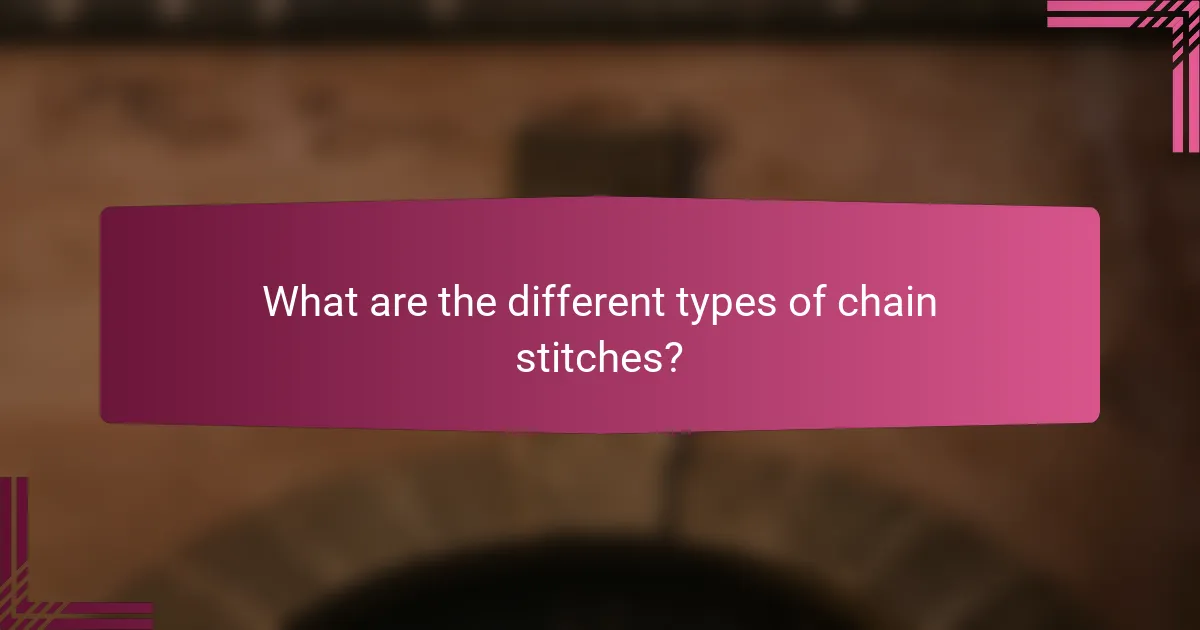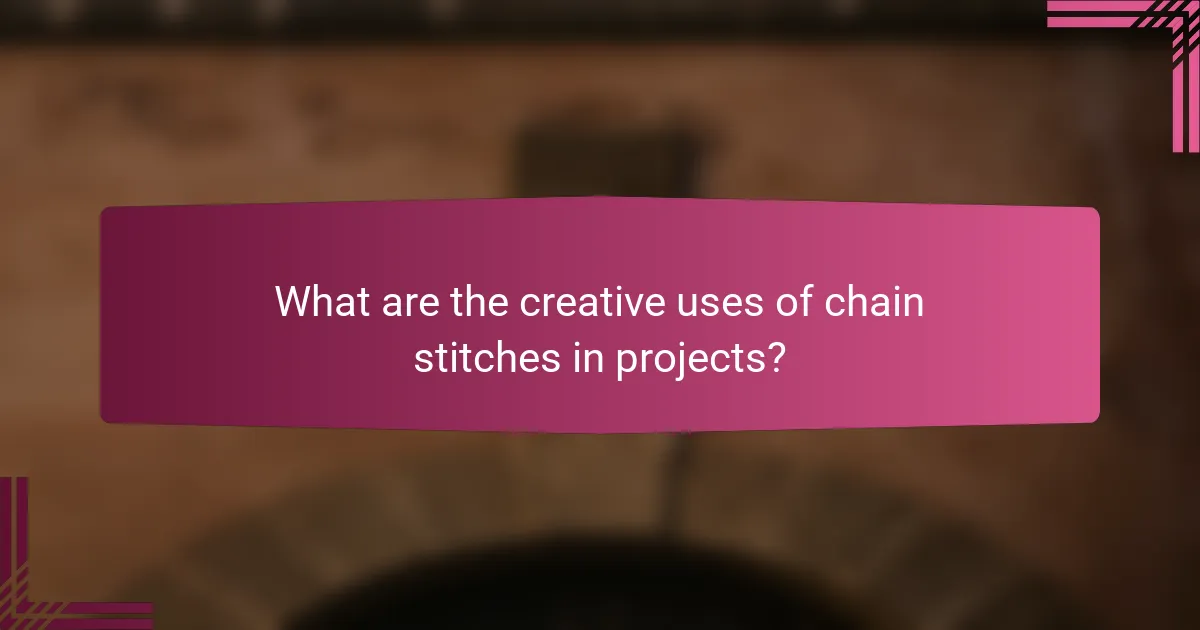
What are the different types of chain stitches?
There are several types of chain stitches. The most common types include the basic chain stitch, double chain stitch, and the closed chain stitch. The basic chain stitch consists of a simple looped stitch. The double chain stitch features two parallel loops, providing added strength. The closed chain stitch forms a continuous loop, often used for decorative purposes. Each type varies in appearance and application. These stitches are fundamental in embroidery and sewing techniques. Their unique characteristics allow for diverse creative uses in textile art.
How do variations in chain stitch types affect their applications?
Variations in chain stitch types significantly affect their applications. Different chain stitch techniques offer unique characteristics suited for various tasks. For instance, the basic chain stitch is commonly used for simple seams and decorative edges. In contrast, the double chain stitch provides added strength, making it ideal for heavy fabrics. The blanket stitch variation is effective for finishing edges and preventing fraying.
Moreover, the looped chain stitch creates a textured surface, which is popular in embroidery and quilting. The application of each type depends on the desired aesthetic and functional requirements. For example, the single chain stitch is often preferred in lightweight fabrics, while the triple chain stitch is utilized for durability in upholstery. Each variation’s specific design influences its practical use in crafting and garment construction.
What are the most common variations of chain stitch?
The most common variations of chain stitch include the single chain stitch, double chain stitch, and triple chain stitch. The single chain stitch is the basic form, creating a simple looped stitch. The double chain stitch features two parallel lines of chain, providing added strength. The triple chain stitch consists of three interlocking loops, enhancing decorative appeal. Each variation serves different purposes in embroidery and sewing projects. These distinctions allow for versatility in fabric art applications.
What unique characteristics distinguish each type of chain stitch?
The unique characteristics that distinguish each type of chain stitch include variations in their structure and application. The basic chain stitch creates a series of interconnected loops. The double chain stitch features two parallel lines of chain, providing extra strength. The triple chain stitch consists of three loops, offering enhanced durability and texture. The ornamental chain stitch incorporates decorative elements, often used for embellishment. The blind chain stitch is designed for hem finishing, remaining hidden on the front side of the fabric. Each type serves distinct purposes in sewing, from functional to decorative.
Why is understanding chain stitch types important for crafters?
Understanding chain stitch types is important for crafters because it affects the quality and versatility of their projects. Different chain stitch types offer unique textures and appearances. Mastering these techniques allows crafters to select the most suitable stitch for their specific needs. For example, some chain stitches are more durable, while others provide decorative effects. Knowledge of these variations enhances a crafter’s skill set. It enables them to innovate and personalize their creations. Additionally, understanding these stitches can improve efficiency in projects. Crafters can save time by choosing the most effective stitch for each application.
How does mastering chain stitch enhance sewing skills?
Mastering chain stitch enhances sewing skills by improving technique and versatility. Chain stitch allows for efficient stitching and is foundational for many sewing projects. This technique creates a strong, decorative seam that is often used in embroidery. Mastering it leads to better control over fabric manipulation. Improved control increases precision in stitching, resulting in higher-quality finished products. Additionally, chain stitch can be used in various applications, from garment construction to decorative elements. As skills develop, sewists can experiment with different patterns and designs using chain stitch. This versatility encourages creativity and personal expression in sewing projects.
What role do chain stitches play in different sewing projects?
Chain stitches serve multiple roles in various sewing projects. They provide a decorative finish and are often used for embellishment. Chain stitches also offer flexibility and stretch, making them ideal for knit fabrics. In garment construction, they can create strong seams that allow for movement. Additionally, chain stitches are useful in quilting for joining layers without bulk. Their ease of unpicking makes them favorable for temporary stitching. Chain stitches can also be used in embroidery, adding texture and visual interest. Overall, they enhance both the functionality and aesthetics of sewing projects.

What techniques are used to create chain stitches?
Chain stitches are created using several techniques, primarily including the basic chain stitch, the double chain stitch, and the looped chain stitch. The basic chain stitch involves forming loops of thread on the fabric surface. This is achieved by inserting the needle through the fabric and pulling the thread to create a loop.
In a double chain stitch, two lines of chain stitches are created side by side for added thickness. The looped chain stitch incorporates additional loops, providing a textured appearance. These techniques can be executed with various types of thread and fabric, allowing for versatility in design.
Chain stitches are commonly used in embroidery and sewing projects, making them a fundamental technique in textile arts.
How can beginners learn chain stitch techniques effectively?
Beginners can learn chain stitch techniques effectively by practicing with clear tutorials and visual aids. Online platforms offer step-by-step videos that demonstrate the process. Using a simple embroidery hoop can help maintain fabric tension. Starting with basic patterns allows beginners to build confidence. Practicing on scrap fabric minimizes frustration. Joining embroidery groups can provide support and feedback. Engaging in hands-on workshops enhances learning through direct instruction. These methods are proven to improve skill acquisition in beginners.
What tools are necessary for creating chain stitches?
To create chain stitches, a needle and thread are necessary tools. The needle should be suitable for the fabric type being used. A specific type of needle, like a tapestry needle, is often preferred for embroidery. The thread can be embroidery floss or any suitable thread for the project. A pair of scissors is also needed to cut the thread. Additionally, a fabric or embroidery hoop can help keep the fabric taut while stitching. These tools collectively enable the creation of chain stitches effectively.
What step-by-step process should beginners follow to master chain stitches?
To master chain stitches, beginners should follow a clear step-by-step process. First, gather the necessary materials: a needle, thread, and fabric. Next, make a small knot at the end of the thread. Insert the needle from the back of the fabric to the front. Pull the needle through until the knot is secure against the fabric.
Then, create a loop by inserting the needle back into the fabric close to where the thread came out. Pull the thread through to form the first chain stitch. Repeat this process by bringing the needle up a short distance away, creating another loop.
Continue this pattern, ensuring each loop connects to the previous stitch. Maintain even tension on the thread to keep the stitches uniform. Practice this technique on scrap fabric to build confidence. Gradually increase the complexity by varying stitch lengths and spacing as proficiency improves.
What advanced techniques can be applied to chain stitching?
Advanced techniques that can be applied to chain stitching include the use of double needle chain stitching and decorative chain stitch patterns. Double needle chain stitching allows for parallel rows of stitching, enhancing durability and aesthetic appeal. Decorative patterns can be created by varying stitch lengths and spacing, which adds texture to fabric. Additionally, incorporating different thread types can yield unique visual effects and improve functionality. These techniques are often used in high-quality garment construction and creative textile applications.
How do variations in tension affect chain stitch quality?
Variations in tension significantly affect chain stitch quality. When tension is too loose, the stitches may appear uneven and can easily unravel. Conversely, excessive tension can cause the fabric to pucker. This results in a distorted appearance of the chain stitch. Proper tension ensures even stitch formation and optimal fabric handling. Consistent tension contributes to durability and a professional finish. Studies show that maintaining ideal tension levels enhances the overall aesthetic of the stitched item. Therefore, adjusting tension is crucial for achieving high-quality chain stitches.
What are the tips for achieving intricate designs with chain stitches?
To achieve intricate designs with chain stitches, use a consistent tension throughout your work. This ensures uniformity in the size of the stitches. Choose a fine needle and thread to create delicate lines. Experiment with different thread colors to enhance the design’s visual appeal. Plan your design on paper before stitching to visualize the outcome. Practice on scrap fabric to refine your technique. Incorporate varying stitch lengths for added texture and depth. Use a hoop to keep the fabric taut, which aids in precision. These tips help create detailed and intricate chain stitch designs.

What are the creative uses of chain stitches in projects?
Chain stitches are versatile and can be creatively used in various projects. They are often employed in embroidery to create decorative borders and outlines. Chain stitches can also be used for adding texture to fabric, enhancing visual appeal. In quilting, they serve as a method for joining layers while providing a unique design element. Additionally, chain stitches are effective in crochet, forming intricate patterns and motifs. Many textile artists utilize them in mixed media art for both functional and aesthetic purposes. Their adaptability allows for use in clothing design, home decor, and craft projects. The flexibility of chain stitches contributes to their popularity in creative textile applications.
How can chain stitches be incorporated into various crafts?
Chain stitches can be incorporated into various crafts through techniques such as embroidery, quilting, and crochet. In embroidery, chain stitches create decorative borders and outlines. They add texture and dimension to fabric art. In quilting, chain stitches can secure layers together while providing a decorative touch. In crochet, chain stitches form the foundation for many patterns. They are essential for creating chains and loops in designs. Chain stitches are versatile and can be adapted to different styles and projects. Their ease of use makes them popular among crafters.
What types of projects benefit from chain stitching?
Chain stitching benefits various types of projects, particularly in garment construction and embroidery. It is commonly used in denim sewing, providing durability and flexibility. Chain stitching is also advantageous for quilting projects, as it allows for easy adjustments. Additionally, it is effective for decorative purposes in fashion design, enhancing visual appeal. Projects requiring stretch, like activewear, benefit from chain stitching due to its elasticity. The technique is also utilized in home décor items, such as curtains and upholstery, for added strength. Overall, chain stitching’s versatility makes it suitable for a wide range of textile applications.
How do chain stitches enhance the visual appeal of handmade items?
Chain stitches enhance the visual appeal of handmade items by adding texture and dimension. This type of stitch creates a series of interconnected loops. These loops can form intricate patterns and designs. The versatility of chain stitches allows for various decorative effects. They can be used in different colors to contrast with the fabric. This contrast further elevates the overall aesthetic of the piece. Additionally, chain stitches can outline shapes or motifs, highlighting key features. Their ability to catch light adds a subtle shine, making the item more visually engaging.
What are some innovative ideas for using chain stitches?
Chain stitches can be used innovatively in various textile applications. One idea is to create decorative borders on garments. This enhances the visual appeal of clothing. Another innovative use is in embroidery for intricate designs. Chain stitches can add texture and depth to fabric art. Additionally, they can be employed in quilting to secure layers. This technique provides both strength and aesthetic value. Chain stitches can also be used in upcycling projects. They can transform old fabrics into unique accessories. Each application showcases the versatility of chain stitches in creative textile work.
How can chain stitches be combined with other stitching techniques?
Chain stitches can be combined with other stitching techniques by layering or alternating them in a design. For example, chain stitches can be used alongside satin stitches to create textured patterns. Combining chain stitches with embroidery techniques like cross-stitch enhances visual interest. Additionally, chain stitches can outline shapes while other stitches fill in the interior. This combination allows for intricate designs and varied textures. Using contrasting thread colors can further highlight the differences between the techniques. Each combination can yield unique artistic effects in fabric art.
What are the best practices for showcasing chain stitch work in finished projects?
To effectively showcase chain stitch work in finished projects, use contrasting backgrounds to highlight the stitch details. Choose fabric colors that complement the thread used in the chain stitch. Frame the work in a way that emphasizes the texture and design created by the stitches. Use proper lighting to enhance visibility and showcase the intricacies of the stitching. Present the piece in a clean, clutter-free environment to draw attention to the chain stitch work. Display the project at eye level for better appreciation of the craftsmanship. Highlight any unique attributes of the chain stitch used, such as variations in size or color. These practices ensure that the chain stitch work is presented in the best possible light.
What tips can help improve chain stitch techniques?
To improve chain stitch techniques, practice consistency in tension. Maintaining even tension creates uniform stitches. Use a high-quality needle suitable for your fabric type. A sharp needle penetrates fabric more easily, enhancing stitch quality. Experiment with different thread types to find the best match for your project. Cotton threads often yield smooth results. Utilize a hoop or frame to stabilize your fabric. This prevents distortion and allows for better control. Additionally, practice regularly to build muscle memory and confidence. Regular practice leads to improved accuracy and speed in stitching.
Chain stitch types are essential techniques in embroidery and sewing, encompassing variations such as the basic chain stitch, double chain stitch, and closed chain stitch. Each type offers unique characteristics that influence their applications, from decorative finishes to strong seams in garment construction. Understanding these variations, along with the techniques for creating them, enhances a crafter’s skills and allows for innovative uses in various textile projects. The article also explores best practices for showcasing chain stitch work and tips for improving stitching techniques, providing a comprehensive resource for both beginners and experienced crafters.
